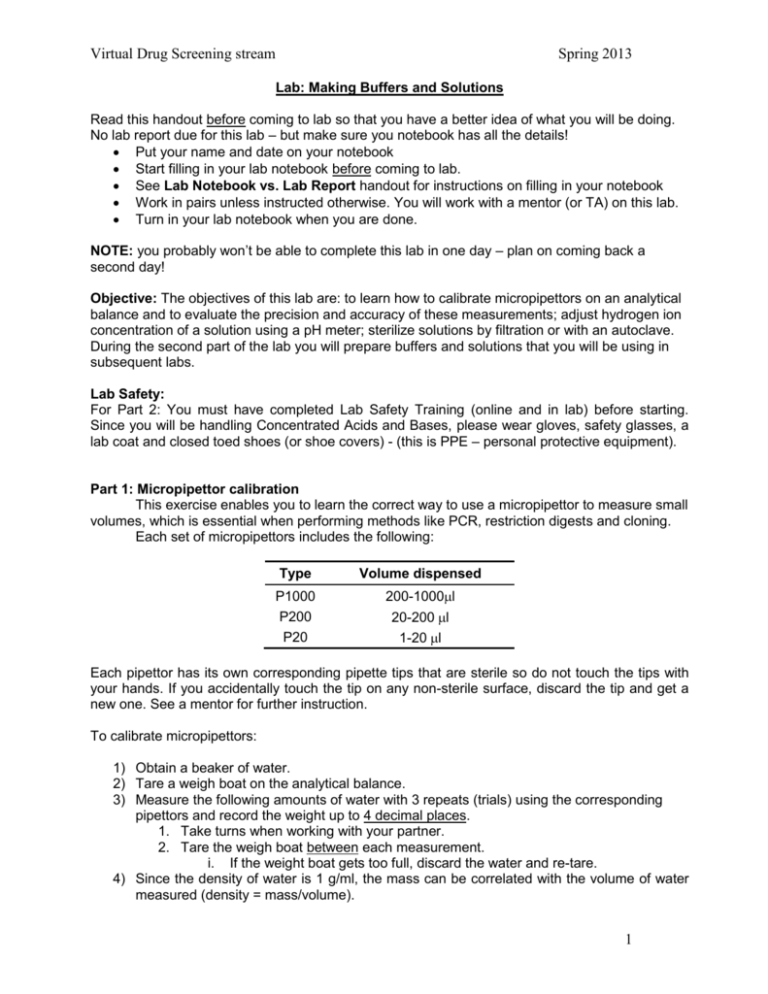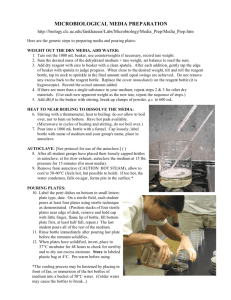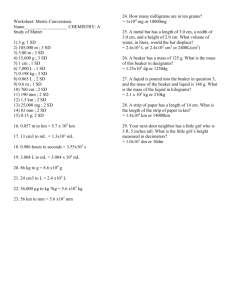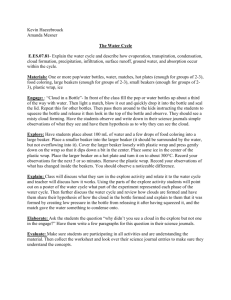LabBuffersandSolutionsVDS_Spring13
advertisement

Virtual Drug Screening stream Spring 2013 Lab: Making Buffers and Solutions Read this handout before coming to lab so that you have a better idea of what you will be doing. No lab report due for this lab – but make sure you notebook has all the details! Put your name and date on your notebook Start filling in your lab notebook before coming to lab. See Lab Notebook vs. Lab Report handout for instructions on filling in your notebook Work in pairs unless instructed otherwise. You will work with a mentor (or TA) on this lab. Turn in your lab notebook when you are done. NOTE: you probably won’t be able to complete this lab in one day – plan on coming back a second day! Objective: The objectives of this lab are: to learn how to calibrate micropipettors on an analytical balance and to evaluate the precision and accuracy of these measurements; adjust hydrogen ion concentration of a solution using a pH meter; sterilize solutions by filtration or with an autoclave. During the second part of the lab you will prepare buffers and solutions that you will be using in subsequent labs. Lab Safety: For Part 2: You must have completed Lab Safety Training (online and in lab) before starting. Since you will be handling Concentrated Acids and Bases, please wear gloves, safety glasses, a lab coat and closed toed shoes (or shoe covers) - (this is PPE – personal protective equipment). Part 1: Micropipettor calibration This exercise enables you to learn the correct way to use a micropipettor to measure small volumes, which is essential when performing methods like PCR, restriction digests and cloning. Each set of micropipettors includes the following: Type Volume dispensed P1000 200-1000l P200 P20 20-200l 1-20l Each pipettor has its own corresponding pipette tips that are sterile so do not touch the tips with your hands. If you accidentally touch the tip on any non-sterile surface, discard the tip and get a new one. See a mentor for further instruction. To calibrate micropipettors: 1) Obtain a beaker of water. 2) Tare a weigh boat on the analytical balance. 3) Measure the following amounts of water with 3 repeats (trials) using the corresponding pipettors and record the weight up to 4 decimal places. 1. Take turns when working with your partner. 2. Tare the weigh boat between each measurement. i. If the weight boat gets too full, discard the water and re-tare. 4) Since the density of water is 1 g/ml, the mass can be correlated with the volume of water measured (density = mass/volume). 1 Virtual Drug Screening stream Spring 2013 5) Record all data in the table below into Excel, perform calculations and then paste into your Lab notebook. P1000 (300l) P1000 (850l) P200 (25l) P200 (155l) P20 (2.5l) P20 (18.25l) 1st Trial: mass [g] 2nd Trial: mass [g] 3rd Trial: mass [g] Average mass [g] Standard Deviation Calculated Vol. [ml] In Microsoft EXCEL® or OpenOffice Calc® 1. Create a spreadsheet with in the following format and enter your data. Use the functions: AVERAGE and STDEV 2. Create a vertical bar chart showing the Average mass for each pippettor Include Error Bars as Standard Deviation (see next page) Error Bars: In order to add the standard deviation as error bars – click on the chart, go to ‘Chart Tools’ then ‘Layout’ then select ‘Error Bars’. DO NOT – do the default ones – instead go to ‘More Options’ From there select ‘Vertical Error Bars’ with ‘Both’ and then ‘Custom’ Click on ‘Specify Value’ then for ‘Positive Error Value’ click and drag on your Standard Deviation values that you calculated. Do the same for the ‘Negative Error Value’ If it places Horizontal Error Bars on the graph – just click and delete them Finish Fig. Error bars in Excel Add a caption to the chart when you place it in your Lab Notebook or in your report. This caption should be descriptive of what was done for the figure: Fig 1: Mass determination of various pippettors using water on an electronic balance. N=3 trials. 2 Virtual Drug Screening stream Spring 2013 SAVE your spreadsheet electronically to a remote location (not just on the local computer) email to yourself or save to your UT Webspace https://webspace.utexas.edu/xythoswfs/webview/xythoslogin.action PRINT and your table and graph (use Page Break View to size appropriately) PASTE into your notebook QUESTIONS TO ANSWER: 1. Make an observation as to which pipettor was most accurate. Is it precise also? Explain St.Dev. 1 x mean2 N 2. Do one Standard Deviation calculation by hand using the above equation. 3. Do the Standard Deviation calculations from EXCEL or OpenOffice match what you get by hand? 4. Why use 1/ N vs. 1/(N-1) as is used in some St. Dev. Calculations? 3 Virtual Drug Screening stream Spring 2013 Part 2: Making Buffers and Solutions One of the key lessons in any Lab is how to make solutions properly. In a research Lab, there is a collection of stock solutions that is used in various protocols. In this lab each team will be responsible for making solutions, buffers, and bacterial media. It is very important for the solutions to be made correctly as the resulting solutions and media will be used throughout the semester. This could make or break your future experiments. Everyone’s Lab notebook should have detailed experimental procedures for all the solutions/buffers/media assigned. You must write these out by hand and show calculations. You will be graded on the level of detail and accuracy of calculations for concentrations. Record the actual amount of each chemical that is weighed out. Solutions to be made: 0.100 L LB broth (autoclaved) 200 ml 0.1M Tris base or Trizma base pH 7.5 using conc. HCl (hydrochloric acid) 1 ml 50 mg/ml Amp (filter sterilized) 50 ml 5 N NaOH (Sodium Hydroxide) 50 ml 10x PBS (Phosphate Buffered Saline, filter-sterilized) 50 ml 1 M Imidazole (filter-sterilized) 100 ml 5x Tris-Glycine-SDS buffer 10 ml of 30% EtOH (ethanol) in autoclaved water Formula weights of all chemicals needed for calculations: Tris or Trizma Base: 121.14 g/mol NaOH: 40 g/mol NaCl: 58.43 g/mol KCl: 74.55 g/mol Na2HPO4: 141.96 g/mol KH2PO4: 136.09 g/mol Imidazole: 68.08 g/mol Glycine: 75.07 g/mol Labeling: *Use labeling tape to label all bottles and tubes with the Date, VDS, your 3-letter initials and teammates initials, contents, pH (if applicable), and molar concentration (if it is a 5x or 10x stock solution – label as such) - put as much information on the label as is practical. Solutions that are filter-sterilized or autoclaved should be labeled “sterile”. 4 Virtual Drug Screening stream Spring 2013 Solution recipes: *All glassware should be rinsed with dH2O before use.* LB broth Bacto-tryptone Bacto-yeast extract NaCl Per liter: 10g 5g 10g Calculate the amount of each compound needed to make only 250 ml. Add dry ingredients to 0.1 L of dH2O in a 0.250 L bottle and then shake to mix thoroughly. Label bottle with regular lab tape. Place foil covering over cap and then autoclave tape. Autoclaving: Mentors and the TA will be responsible for autoclaving. However, if you do help autoclave solutions, make sure that the bottle or flask is twice the volume of the solution. This will prevent bubbling over of solution in autoclave due to high heat and high pressure. FOR AUTOCLAVING DO NOT TIGHTEN THE CAP ON THE BOTTLE. IF THE BOTTLE IS TIGHTLY CAPPED, IT MIGHT EXPLODE Loosen the cap a few turns Place autoclave tape on the container that will be autoclaved as an indicator that the solution is sterile (the tape will change appearance after autoclaving – due to temperature sensitive black stripes). Place your solution with the others to be autoclaved. The mentors will autoclave for you. Be sure that anything you autoclave is placed in an autoclavable tray (ask RE/TA/mentor). Autoclave the LB solution for 30 min on liquid cycle. Proceed to make the other solutions while autoclave is running. When autoclave is complete the bottle will be hot so use oven mittens when handling. Tighten cap and store LB media in -4oC fridge. 200 ml 0.1 M Tris Base pH 7.5 – to act as a buffer Calculate the amount in g of Tris Base needed to make solution. Pour 80 ml Nanopure water into a 200 ml glass beaker. Weigh out the appropriate amount of Tris base and add to water. Place a stir bar in and stir vigorously on stir plate until dissolved. CALIBIRATE the pH meter (ask RE/TA/mentor for help – instructions printed out by pH meter – see attached sheets). Rinse probe with Nanopure water and dip into solution above the stir bar (tip of probe is fragile so be careful!). Be sure to rinse probe before moving to the next calibration solution to prevent contamination. Lab Safety: Since you will be handling a concentrated acid and/or base, please wear gloves, safety glasses, a lab coat and closed toed shoes (or shoe covers). You must do this step with a mentor watching. Also, as a strong acid – add it slowly. Add conc HCl slowly using a glass Pasteur pipette and rubber bulb until pH reaches 7.5. (HCl is stored in the acids cabinet in a secondary containment vessel). Pour solution into a 250 ml graduated cylinder. Rinse the beaker with a small amount of Nanopure and add to graduated cylinder until you reach the 200 ml mark. Pour into a glass bottle, label and store at room temperature. Replace HCl acid to the acids cabinet when done. 5 Virtual Drug Screening stream Spring 2013 1 ml of 50 mg/ml Ampicillin solution – an antibiotic Calculate amount of Amp powder needed for 1 ml. Weigh out Ampicillin and place in a 1 ml Eppendorf microcentrifuge tube. Add 1 ml of dH2O and vortex to mix. Once solid it is dissolved, filter-sterilize the solution through a 0.22 m syringe filter fitted on a 1 or 2 ml syringe. Dispense filtered solution into a sterile 1 ml Eppendorf tube. Check volume after filtering as usually some volume is left behind in the filter unit. Wrap the tube in foil, label it with Name, Date, VDS and ‘AMP 50 λ’ and store the solution in -20oC freezer. λ is the Greek symbol for lambda and is used as short hand in the lab for micrograms/microliter (and equivalently milligrams/milliliter) 50 ml 5 N (normality) NaOH - base Calculate the amount in g of NaOH needed to make solution a 5 Normal solution (Normality is a measure of how many free ions there are when solubilized). Place 25 ml of Nanopure water into a 100 ml beaker. Weigh out NaOH pellets and place into beaker. Place your hand on the side of the beaker – any observations? Place a stir bar into beaker and stir solution on stir plate until all solid is dissolved. Transfer the mixture into a 50 ml volumetric flask (bulb at base with skinny neck). Add a small amount of Nanopure water to beaker to rinse off and add to flask until you reach the 50 ml mark. Then pour contents into a glass bottle, label the bottle and store at room temperature. 50 ml 1 M Imidazole – used in protein purification lab to free your protein Calculate the amount in g of imidazole needed to make the solution. Place 40 ml of dH2O into a 100 ml beaker. Weigh out the imidazole and add to the beaker. Place a stir bar into beaker and stir solution on stir plate until all solid is dissolved. Transfer the mixture into a 50 ml graduated cylinder. Add a small amount of dH2O to beaker to rinse off and add to cylinder until you reach the 50 ml mark. Filter the solution using a bottle-top vacuum filter attached to the running faucet for suction, label the bottle and store at room temperature. If possible use the bottle-top vacuum filters that dispense into a new 50 ml conical tube instead of a bottle. 50 ml 10X PBS (phosphate-buffered saline) 10X stock solution, per liter: 80 g NaCl 2 g KCl 14.4 g Na2HPO4 2.4 g KH2PO4 Calculate the amount in g of each compound needed to make 50 ml of the solution. Place 40 ml of dH2O into a 100 ml beaker. Weigh out the compounds and place into beaker. Place a stir bar into beaker and stir solution on stir plate until all solid is dissolved. Transfer the mixture into a 50 ml graduated cylinder. Add a small amount of dH2O to beaker to rinse off and add to cylinder until you reach the 50 ml mark. Filter the solution using a bottle-top vacuum filter, label the bottle and store at room temperature. If possible use the bottle-top vacuum filters that dispense into a new 50 ml conical tube instead of a bottle. Working solution, pH ~7.4: 137 mM NaCl 2.7 mM KCl 10 mM Na2HPO4 1.8 mM KH2PO4 100 ml 5x Tris-glycine-SDS (TGS) running buffer – for gel electrophoresis of proteins 1.51 g Tris base 6 Virtual Drug Screening stream Spring 2013 9.4 g glycine 0.5 g SDS Add 80 ml dH2O into a 200 ml beaker. Weigh out compounds and add to beaker. Place a stir bar into beaker and stir solution on stir plate until all the solid is dissolved. Transfer the mixture into a 100 ml graduated cylinder. Add a small amount of dH2O to beaker to rinse off and add to cylinder until you reach the 100 ml mark. Transfer to a glass bottle, label, and store at room temperature. Working solution, pH ~8.6: 25 mM Tris 250 mM glycine 0.1% SDS 10 ml of 30% EtOH (ethanol) in autoclaved water – for resin storage Calculate how much 200 Proof ethanol should be added to sterile, autoclaved water to give a 30% ethanol concentration in 10 ml final volume. Obtain a sterile 15 ml conical tube. Using a pipette bulb and pipette add water from one of the prepared bottles of autoclave water. Then using clean technique (DO NOT USE A BURNER) and a new pipette – transfer the right amount of ethanol from the stock container into your 15 ml conical tube. Label, and store at room temperature. 7 Virtual Drug Screening stream Spring 2013 General Information about Stock solutions: concentration and dilution Making stock solutions: Concentrations of solutions can be expressed in different ways such as: Molarity, M; Normality, N; Mass-volume percentage, % (w/v); Volume-volume percentage, % (v/v); or given as a recipe per liter solution. There are many other was that concentration can be expressed, but they are less common in a Biochemistry lab and aren’t covered here. See http://en.wikipedia.org/wiki/Concentration#Molality for a more complete discussion. Molarity Molarity is expressed as the number of moles per liter of solution, mol/L, and is most often used to describe dilute aqueous solutions. You need to know the molecular or formula weight of the compound to calculate molarity. For instance: If you need to make 200 ml of a 3 M solution of a compound with a formula weight of 55.05 g, the calculation would be 𝑔 𝑚𝑜𝑙 1𝐿 55.05 𝑥3 𝑥 200 𝑚𝑙 𝑥 = 33.03 𝑔 𝑚𝑜𝑙 𝐿 1000 𝑚𝑙 It’s easy to see that you are doing the calculation correctly if you carry the units along and cancel them out. If you are making a solution that contains more than one component, calculate the amount that you would need of each separately and add to the same volume. Normality Normality is most often used for solutions of acids and bases and typically is used to express the concentration of protons or hydroxide ion in solution. In the case of sulfuric acid (H2SO4) the Normality of protons is twice the Molarity of H2SO4 (there are 2 molar equivalents of protons per mole of sulfuric acid). For the trivial example of HCl or NaOH, the Molarity and Normality are equal. Mass-volume percentage, % (w/v) Mass-volume (or weight-volume) percentage is commonly used for solutions of detergents and polyethylene glycols and is a measure of the grams of solute per 100 ml of final solution. It is important when making solutions with a high percentage that the total volume, not the volume of liquid added, is used. An example is a 10% SDS solution, which has 10 g SDS per 100 ml resulting solution. Volume-volume solution, % (v/v) Volume-volume percentage solutions are often used when a liquid-liquid solution is prepared, such as for glycerol or ethanol. An 80% glycerol solution contains 80 ml glycerol per 100 ml final solution. To prepare an 80 % v/v solution, 80 ml should be added to a graduated cylinder and water added to the 100 ml mark. After mixing thoroughly, the final volume should be adjusted to 100 ml. Solutions or media prepared by using a given recipe Many times, media (such as LB, Luria-Bertani media) and multi-component buffer solutions (such as phosphate-buffered saline) are given as a recipe of how much of each compound to use to prepare 1 L. In this case an adjustment for the volume actually being prepared needs to be made. For example, the recipe for LB is 10 g tryptone, 5 g yeast 8 Virtual Drug Screening stream Spring 2013 extract, and 10 g NaCl per liter. To prepare 0.2 L the problem can be stated: 10 g per 1 liter is equivalent to how many g for 0.2 L? This can be written in equation form as: 10 g xg 1L 0.2 L Solving for x gives: 0.2 L x 10 g 2g 1L You need to perform the calculation for each separate component in the media or buffer. Dilutions: You have a 5 M stock solution and need 1 L of a 200 mM (0.2 M) solution. The calculation to use is V1 x C1 = V2 x C2 (sometimes stated M1 x V1 = M2 x V2). Where V is volume, C is concentration and M is molarity. In this case we know the starting and final concentrations and the final volume, so: 𝑚𝑜𝑙 𝑚𝑜𝑙 𝑉1 𝑥 5 = 1 𝐿 𝑥 0.2 𝐿 𝐿 Rearranging gives V1 = 0.04 L = 40 ml. If you have 1 ml of a 2 M solution and dilute it to 10 ml, you know the starting and final volumes and the starting concentration and need to calculate the final concentration: 𝑉1 𝑥 𝐶1 = 𝐶2 𝑉2 Or in this case: (1 ml x 2 M)/ 10 ml = 0.2 M. 9





